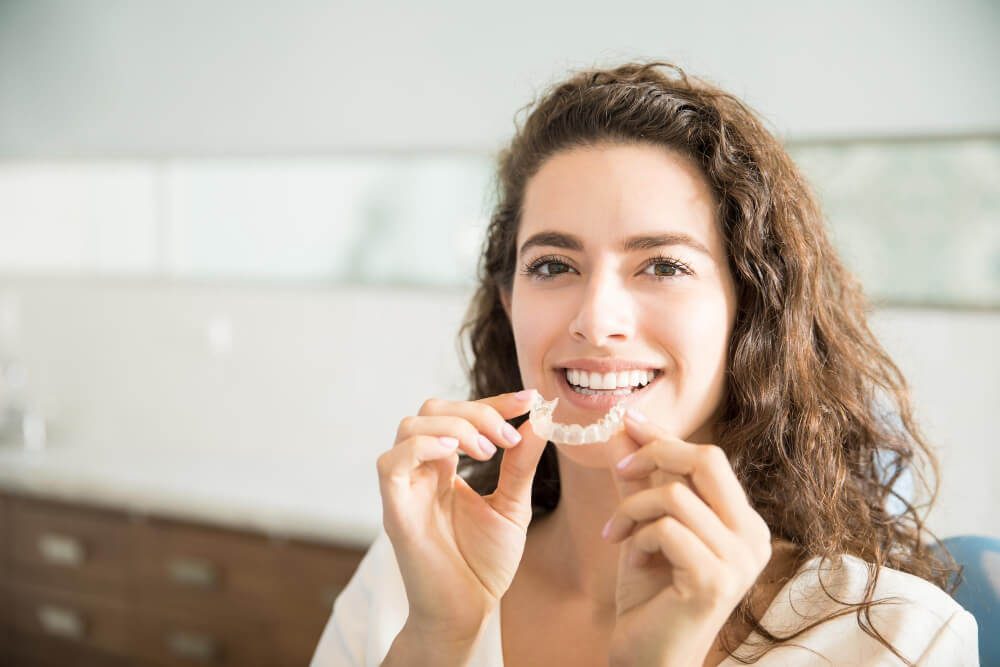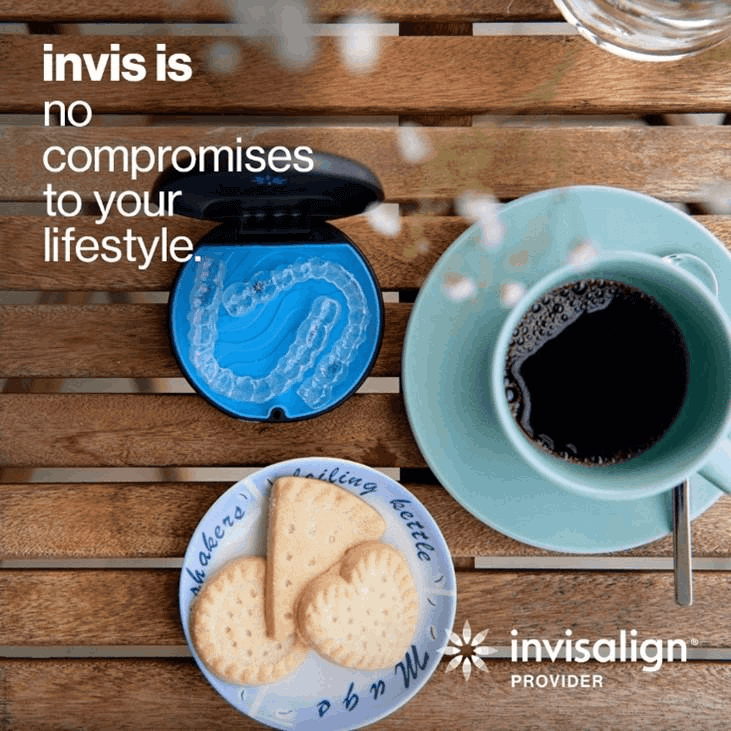Ask the Dentist: A Complete Guide to Invisalign and Clear Aligner Treatment

Straightening your teeth has never been more discreet or comfortable. Clear aligners, like Invisalign, Spark Aligners, Clear Correct, have revolutionised orthodontic treatment, offering a nearly invisible alternative to traditional braces. At My Local Dentists, we understand the importance of informed decisions for patients in dental care. This guide delves into how clear aligners work, their advantages and disadvantages compared to traditional braces, the leading brands available, and the cutting-edge technology behind them. And importantly we have also provided some reference material as well.
What Are Clear Aligners?
So what exactly are clear aligners? Clear aligners are custom-made, clear plastic trays designed to fit snugly over your teeth, gradually moving them into the desired position. Some patients think that Invisalign are Clear Aligners. But Invisalign is just a brand of clear aligners, much like Apple iPhones are just a brand of smart phones. There are lots of other brands including Spark Aligners, Clear Correct, Angel Aligners, etc. Unlike traditional braces, clear aligners are removable and virtually invisible, making them a popular choice among adults, teenagers and children seeking a discreet orthodontic solution.
Step by Step Guide on Clear Aligners: How Do Clear Aligners Work?
Step 1
- Consultation: Your dentist needs to assess your teeth and make sure you are suitable for clear aligners.
- Scans and Photos – The treatment process begins with a consultation appointment where your treating dentist will take a set of photos and digital scans of your teeth.
Step 2
- Design and Setup – Using advanced computer software, a treatment plan is created to provide a simulation of the expected treatment sequence with a series of aligner trays, each slightly different to move your teeth incrementally. The more complicated and crooked your teeth, the more trays you may need.
Step 3
- Appointment to Place Attachments Buttons and Issue Trays – Tooth coloured attachments or “buttons” may be added to some of your teeth to help with the movement, and elastics may be used to help correct bite issues. Patients typically wear each set of trays for 1–2 weeks, for 20–22 hours daily, removing them only for eating, drinking, brushing, and flossing. You will expect a minor bit of pressure and soreness when you first start wearing the trays until your teeth get used to it after a couple of days
Step 4
- Ongoing Review Appointments and Issue New Trays – Over time, with each sequence of wearing the trays, this consistent pressure shifts teeth into alignment.
Step 5
- Revision Trays – Possible New Scans and Photos – The first series of trays may get you 90-95% there with the teeth straightness and alignment, but it is normal for your dentist to take new photos and scans of your teeth and order more trays to refine the teeth straightening and give you the finishing touches that will give you a happy straight smile
Step 6
- Case Finishing – This step will involving discussing your results with your dentist and making sure you’ve been able to achieve the goals from the start – a healthy straight smile. There are lots of different factors that come into play depending on how your original teeth started looking, how old you are, how well your compliance is with weaning the retainers, how your teeth are responding to treatment
- If your original teeth are chipped and worn down, you may want to consider doing placing some composite resin bonding fillings onto your teeth to give it that perfect finish
Step 7
- Retainers – Once you are happy, the next steps are to organise getting retainers made to help keep your teeth straight. Teeth straightening is half the equation. Keeping them straight with retainers is the other half of the equation.

Pros and Cons: Clear Aligners vs. Traditional Braces
Clear Aligners:
Pros:
-
- Aesthetically pleasing and nearly invisible
- Can be removed so it’s comfortable for meals and oral hygiene (brushing and flossing)
- Food doesn’t get stuck like with traditional braces
- Fewer dietary restrictions
- Comfortable, with no metal brackets or wires
Cons:
- Requires strict compliance; must be worn 22+ hours per day for treatment to work
- Not ideal for very complex orthodontic cases
- May be more expensive than traditional braces
Traditional Braces:
Pros:
-
- Effective for a wide range of complex dental issues
- No need to remember to wear them
- A little bit more affordable
Cons:
- Visible metal brackets and wires
- When the braces are first glued on, they are sore for about a week
- Potential discomfort from brackets and wires
- Dietary restrictions to avoid damaging braces
- Food gets stuck during and after meals
- More challenging oral hygiene maintenance
Ultimately, the choice between clear aligners and traditional braces depends on individual needs, lifestyle, and the complexity of the dental issues.
The Technology Behind Clear Aligners
Clear aligners leverage advanced digital technology to plan and execute precise tooth movements. 3D imaging and computer-aided design allow for the creation of custom aligners that fit snugly and apply targeted pressure. Materials like SmartTrack (used by Invisalign) enhance comfort and control. Some brands are exploring the use of artificial intelligence to predict treatment outcomes and improve efficiency
Research and Effectiveness
Studies have shown that clear aligners are effective for treating various orthodontic issues, particularly mild to moderate cases. Advancements in materials and technology have improved their capability to handle more complex movements. However, the success of treatment heavily relies on patient compliance. Wearing aligners for the recommended 20–22 hours daily is crucial for achieving desired results
Choosing the Right Treatment for You
Selecting the appropriate orthodontic treatment involves considering various factors:
- Severity of Dental Issues: Complex cases may require traditional braces.
- Lifestyle: If discretion and flexibility are priorities, clear aligners may be preferable.
- Budget: Evaluate the cost differences and available payment options.
- Commitment: Clear aligners require discipline in wearing them as prescribed.
Consulting with a qualified dental professional is essential to determine the most suitable treatment plan tailored to your needs.

Clear Aligner Brands: Why the Brand Matters Less Than the Dentist’s Skill
With the rising popularity of clear aligners for teeth straightening, several brands have entered the market, each offering variations in material, treatment options, and cost. While patients often ask, “Which brand is best — Invisalign, ClearCorrect, or Spark Aligners?” — the more important question should be, “Which dentist or orthodontist is best equipped to plan and manage my treatment?”
Leading Clear Aligner Brands
- Invisalign
Invisalign is the most established brand in the clear aligner industry, introduced in the late 1990s. Manufactured by Align Technology, Invisalign uses proprietary SmartTrack material and SmartForce attachments for more precise control of tooth movements. Invisalign has been one of the leaders in clear aligner technology, capable of treating a wide range of orthodontic issues, including more complex cases when planned by an experienced clinician. - Spark Aligners
Spark aligners are known for their crystal-clear appearance and highly durable TruGEN™ material. Spark claims to offer better comfort and clarity, and is increasingly favoured by orthodontists and experienced clinicians for complex cases. - ClearCorrect
Developed in the U.S. and used globally, ClearCorrect is another dentist-delivered clear aligner option. While similar to Invisalign, it offers slightly different pricing models and aligner staging. ClearCorrect aligners are made from a material called ClearQuartz™, which is engineered to resist staining and provide optimal force delivery. - Angel Align, Byte, SureSmile, and others
Several other brands such as Byte (popular in the U.S.), SureSmile, and Angel Align (growing in Asia-Pacific markets) are available depending on the region and provider. These systems may offer slight differences in aligner thickness, wear schedule, or support tools like vibration devices — but the underlying principle remains the same: clear, sequential tooth movement guided by plastic trays. - Direct to Consumer
There are companies that operate on a direct-to-consumer (DTC) model, meaning patients can receive aligners without seeing a dentist. While more affordable, this model is typically limited to very mild cases and comes with a lot of risks due to the lack of any supervision from a qualified health professional. Some of these companies have gone into bankruptcy and ceased operations, leaving patients untreated and losing money.
The Brand is Only the Tool — The Clinician is the Architect
While marketing around clear aligner brands focuses heavily on technology, material names, and online convenience, what truly determines the success of your orthodontic treatment is not the brand — it’s the skill, experience, and judgment of the clinician.
Here’s why:
- Diagnosis is Everything: A good dentist or orthodontist will perform a full clinical examination and 3D imaging to assess not just your teeth, but also your bite, jaw position, gum health, and skeletal structure. Brands don’t do this — people do.
- Treatment Planning: Aligners don’t move teeth; treatment plans do. Sophisticated 3D software is only as effective as the clinician using it. A poorly planned case with a premium brand can fail, while a well-executed plan using a less known brand can succeed.
- Mid-course Corrections: Teeth don’t always move as predicted. Experienced clinicians monitor progress and make refinements — like adding attachments, using elastics, or ordering additional aligners. This level of adaptability isn’t brand-dependent; it’s clinician-dependent.
- Managing Complex Cases: Not every case is suitable for clear aligners. A skilled clinician can determine when to switch to braces, combine appliances, or even recommend surgical options for jaw-related issues. Brand software cannot make those calls.
- Patient Compliance Coaching: Wearing aligners for 22 hours a day isn’t always easy. Clinicians play a key role in keeping patients motivated, informed, and on track

What This Means for You
When choosing clear aligners, don’t focus solely on which brand is “best.” Instead, ask:
- Does this dentist or orthodontist have training in clear aligner therapy?
- How experienced are they?
- Can they explain the pros and cons of clear aligners for my unique situation?
- Do they offer regular reviews and refinements during treatment?
- Will they be available to support me if things don’t go as planned?
At My Local Dentists, our experienced team has provided lots of successful clear aligner treatments for our patients using Invisalign, Spark Aligners, Clear Correct and other systems. We tailor each treatment plan to your individual goals and lifestyle, using the right tools — and the right clinical judgment — to achieve lasting, beautiful results.
Conclusion
Clear aligners have transformed the landscape of orthodontic treatment, offering a discreet, comfortable, and effective solution for many patients. While they present numerous advantages, it’s important to assess their suitability on a case-by-case basis. At My Local Dentists, our friendly and experienced team is dedicated to guiding you through your orthodontic journey, ensuring optimal results and a confident smile.
References
- Effectiveness and predictability of treatment with clear orthodontic aligners: A systematic review. ScienceDirect.
- Invisalign vs. Braces: Which Is the Better Option? Verywell Health.
- An Expert’s Guide to Clear Aligner Treatment. Orthodontics Australia.
- Emerging insights and new developments in clear aligner therapy: A review. ScienceDirect.
The 50 most-cited articles on clear aligner treatment: A bibliometric analysis. American Journal of Orthodontics and Dentofacial Orthopedics.(sciencedirect.com, verywellhealth.com, orthodonticsaustralia.org.au, sciencedirect.com, ajodo.org)
